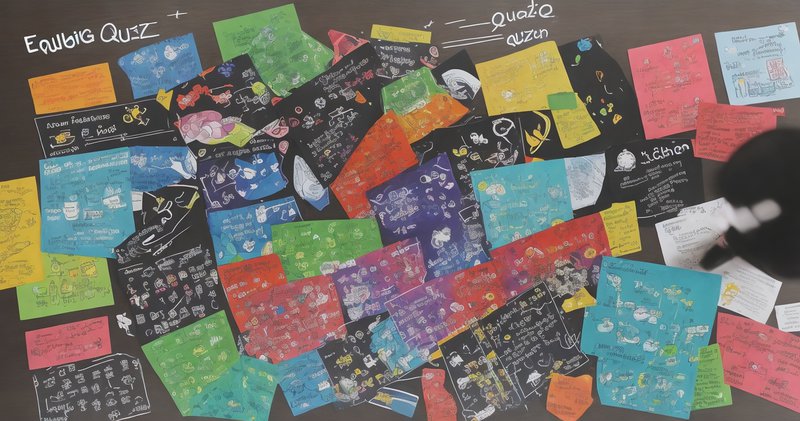How To Create Engaging Quizzes And Polls For Audience Interaction?

Quizzes and polls have become increasingly popular tools for engaging audiences and promoting interaction in various settings, including classrooms, meetings, and online platforms. The ability to capture and maintain the attention of the audience is crucial for any successful engagement strategy. This article explores the key principles and strategies for creating engaging quizzes and polls that effectively promote audience interaction.
To begin, understanding the audience is essential. By identifying their interests, preferences, and knowledge levels, quiz creators can tailor their questions and content accordingly. Additionally, choosing the right platform is crucial as it can significantly impact the overall engagement and accessibility of the quizzes and polls.
Clear objectives need to be set to ensure that quizzes and polls serve a specific purpose, whether it is to educate, entertain, or collect feedback. Creating engaging and relevant questions that challenge the audience’s knowledge and stimulate critical thinking is another crucial aspect. Incorporating visuals and multimedia elements can further enhance the overall experience and captivate the audience.
Providing instant feedback is a powerful motivator for participants, as it allows them to assess their performance and learn from their mistakes. Encouraging competition and offering rewards can also boost engagement and foster a sense of achievement.
Analyzing the results of quizzes and polls provides valuable insights into the audience’s preferences, knowledge gaps, and areas of improvement. By continuously improving and innovating based on these findings, creators can ensure that their quizzes and polls remain engaging and relevant over time.
In conclusion, creating engaging quizzes and polls requires careful consideration of the audience, objectives, questions, visuals, feedback, and rewards. By following these principles and continuously analyzing and improving their strategies, creators can effectively promote audience interaction and enhance the overall engagement experience.
Understand Your Audience
Understanding the characteristics and preferences of your audience is essential for creating quizzes and polls that effectively engage and captivate them. By gaining insight into their demographics, interests, and knowledge levels, you can tailor your quizzes and polls to suit their specific needs and interests.
Conducting surveys or analyzing existing data can provide valuable information about your audience’s age, gender, education level, and areas of interest. Additionally, understanding their preferences in terms of question format, difficulty level, and topics of interest can help you design quizzes and polls that are more likely to resonate with them.
By taking the time to understand your audience, you can create interactive quizzes and polls that not only capture their attention but also provide an enjoyable and meaningful experience.
Choose the Right Platform
To effectively implement interactive assessments, selecting the appropriate platform is crucial for facilitating dynamic and immersive experiences. The choice of platform can significantly impact the engagement and effectiveness of quizzes and polls. When deciding on a platform, consider the following factors:
- User-friendly interface: A platform should be easy to navigate and use, ensuring a seamless experience for both the creator and participants.
- Customization options: Look for platforms that offer a range of customization features, such as branding options, question types, and visual elements, allowing you to create quizzes and polls tailored to your specific needs.
- Integration capabilities: Consider platforms that can integrate with other tools and platforms you use, such as learning management systems or social media, to maximize reach and accessibility.
By carefully selecting the right platform, you can enhance audience interaction and create engaging quizzes and polls that effectively meet your objectives.
Set Clear Objectives
Setting clear objectives is essential for effectively implementing interactive assessments, as it provides a focused direction for designing and conducting quizzes and polls. Objectives help define the purpose and desired outcomes of the assessment, ensuring that it aligns with the overall goals of the educational or interactive session. When setting objectives for quizzes and polls, it is important to consider the specific knowledge or skills that need to be assessed, as well as the level of engagement and interaction desired from the audience. By clearly articulating the objectives, educators or presenters can design questions and activities that target these objectives and measure the participants’ understanding or opinions effectively. This not only enhances the learning experience but also helps in evaluating the success of the interactive assessment.
| Objective | Description |
|---|---|
| Assess knowledge | Measure participants’ understanding of specific topics or concepts. |
| Gather feedback | Obtain participants’ opinions, preferences, or suggestions on a particular subject. |
| Promote engagement | Encourage active participation and interaction among the audience. |
Create Engaging and Relevant Questions
Developing thought-provoking and relevant questions is crucial for fostering active participation and promoting meaningful discussions within the educational or interactive session. When creating quizzes and polls, it is important to consider the audience’s level of knowledge and interests to ensure engagement.
Questions should be clear, concise, and aligned with the objectives of the session. They should be designed to stimulate critical thinking, encourage analysis, and provoke discussion among participants. Open-ended questions can be particularly effective in eliciting diverse perspectives and promoting deeper understanding.
Additionally, incorporating real-life scenarios or examples can enhance relevance and applicability of the questions. By creating engaging and relevant questions, facilitators can create an interactive and dynamic learning environment that encourages active participation and enhances the overall learning experience.
Incorporate Visuals and Multimedia
Incorporating visuals and multimedia enhances the learning experience by providing visual representations and interactive elements that engage the audience and facilitate understanding. Visuals such as images, videos, and graphs can help to clarify complex concepts or illustrate examples, making the content more accessible and relatable. Moreover, multimedia elements can capture the attention of the audience and create a dynamic and interactive environment. For instance, quizzes and polls can be presented using interactive features, such as drag-and-drop exercises or clickable options, which encourage active participation and keep the audience engaged. Additionally, incorporating visuals and multimedia can cater to different learning styles, as some individuals may prefer visual or auditory stimuli over textual content. Overall, the use of visuals and multimedia in quizzes and polls can greatly enhance audience interaction and improve the overall learning experience.
| Pros | Cons |
|---|---|
| Enhances understanding | May distract from the main content |
| Engages audience | Requires additional time and resources for creation |
| Appeals to different learning styles | Accessibility concerns for visually impaired individuals |
Provide Instant Feedback
Instant feedback is a valuable instructional tool that provides timely information to learners, allowing them to assess their understanding and make necessary adjustments for improved learning outcomes. When incorporating quizzes and polls for audience interaction, providing instant feedback can enhance the engagement and effectiveness of the activity.
Here are four reasons why instant feedback is important:
- Reinforcement: Immediate feedback reinforces correct responses and helps learners remember the information more effectively.
- Motivation: Instant feedback motivates learners by acknowledging their progress and providing encouragement to continue learning.
- Error correction: Feedback helps learners identify and correct any misconceptions or errors in their responses, promoting deeper understanding.
- Active learning: By receiving immediate feedback, learners actively participate in the learning process, making it more engaging and interactive.
By integrating instant feedback into quizzes and polls, educators can create a more interactive and effective learning experience for their audience.
Encourage Competition and Rewards
Encouraging competition and offering rewards can foster a sense of motivation and engagement among learners, leading to improved learning outcomes. Competitions create a stimulating environment where participants strive to outperform their peers, driving them to put in extra effort and enhancing their learning experience.
By introducing rewards, such as certificates or prizes, learners are incentivized to actively participate and excel in quizzes and polls. The element of competition instills a sense of urgency and excitement, motivating learners to actively engage in the learning process.
Additionally, rewards act as tangible recognition of learners’ achievements, boosting their self-esteem and confidence. This positive reinforcement reinforces their commitment to future learning activities.
However, it is crucial to strike a balance between healthy competition and collaboration, ensuring that learners focus on personal growth and development rather than solely on winning.
Analyze and Learn from the Results
Analyzing and learning from the results allows educators to gain valuable insights and make informed decisions about the effectiveness of their teaching methods and learning materials. By carefully examining the data gathered from quizzes and polls, educators can identify areas of strength and weakness in their instructional approach. This analysis can help them understand which topics or concepts students struggle with the most, enabling them to tailor their teaching to address these areas more effectively.
Moreover, analyzing quiz and poll results can provide educators with feedback on the clarity and relevance of their questions, helping them refine their assessment techniques. Additionally, educators can identify patterns and trends in student responses, allowing them to adapt their teaching strategies accordingly.
Finally, analyzing quiz and poll results can also provide valuable information for curriculum development and future instructional planning.
- Identify areas of strength and weakness in instructional approach
- Tailor teaching to address areas of difficulty more effectively
- Refine assessment techniques and question clarity
- Adapt teaching strategies based on response patterns and trends
- Inform curriculum development and instructional planning
Continuously Improve and Innovate
Continuously improving and innovating in education is essential for educators to stay up-to-date with the latest advancements and ensure students are receiving the most effective and engaging learning experiences. When it comes to creating quizzes and polls for audience interaction, this principle holds true.
Educators should strive to constantly improve and innovate their quiz and poll designs to enhance student engagement and learning outcomes. This can be achieved through various methods, such as seeking feedback from students and colleagues, analyzing data and insights gathered from previous quizzes and polls, and staying informed about new technologies and teaching strategies.
By continuously refining and experimenting with different approaches, educators can create quizzes and polls that are more interactive, thought-provoking, and tailored to the specific needs and preferences of their students.
This continuous improvement and innovation in quiz and poll creation can ultimately contribute to a more effective and engaging educational environment.
Frequently Asked Questions
What are some common mistakes to avoid when creating quizzes and polls for audience interaction?
Some common mistakes to avoid when creating quizzes and polls for audience interaction include: unclear or ambiguous questions, biased or leading options, too many or too few options, overly complex or difficult questions, and not providing feedback or explanations for answers.
How can I ensure that my quiz or poll is accessible to all members of my audience?
Ensuring accessibility of quizzes and polls to all audience members can be achieved by considering various factors such as providing alternative formats for visually impaired individuals, using clear and concise language, and allowing for multiple modes of participation.
Are there any specific guidelines or best practices for incorporating visuals and multimedia into quizzes and polls?
Guidelines and best practices for incorporating visuals and multimedia into quizzes and polls include using high-quality images, videos, and audio that are relevant to the content, keeping the media brief and concise, and ensuring accessibility for all audience members.
What are some effective strategies for encouraging audience participation and engagement in quizzes and polls?
Effective strategies for encouraging audience participation and engagement in quizzes and polls include providing clear instructions, using interactive formats, incorporating gamification elements, offering incentives or rewards, promoting social sharing, and analyzing and utilizing feedback for improvement.
How can I effectively measure the success and impact of my quizzes and polls on audience interaction?
To effectively measure the success and impact of quizzes and polls on audience interaction, various metrics can be utilized, such as response rates, engagement levels, and post-engagement actions. These quantitative measures provide objective insights into the effectiveness of the quizzes and polls.




